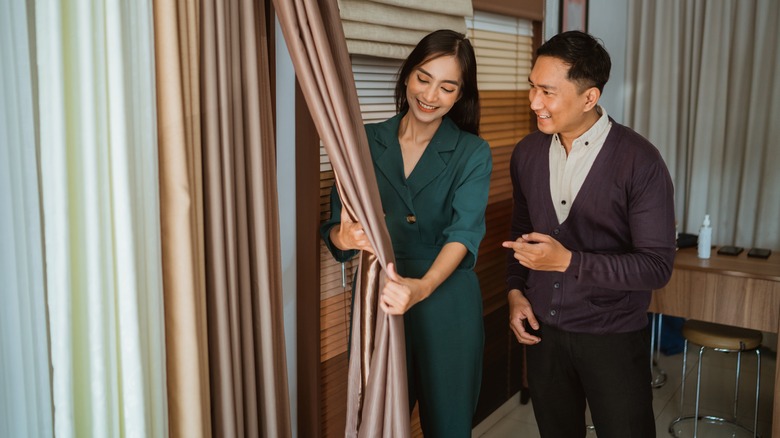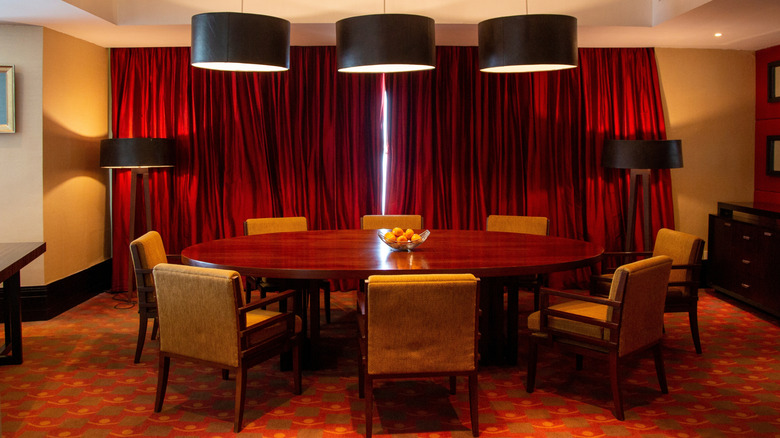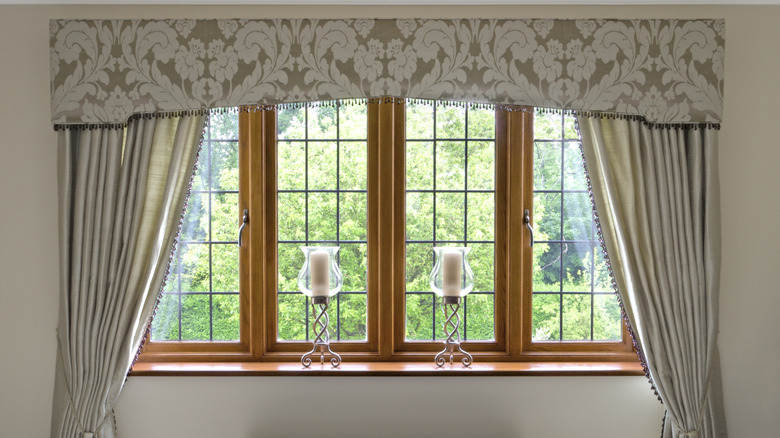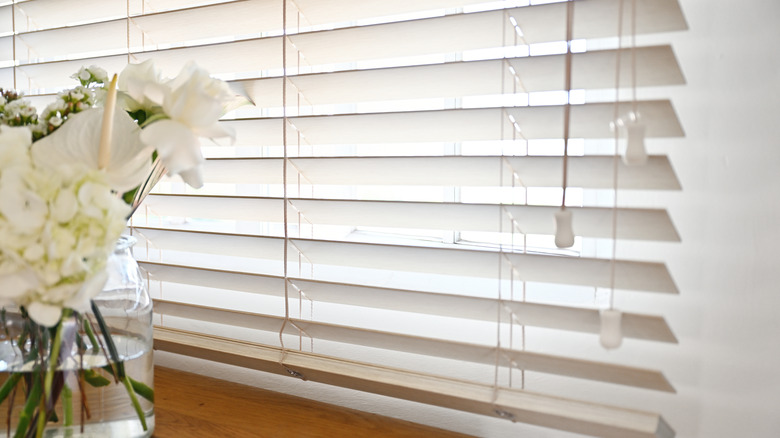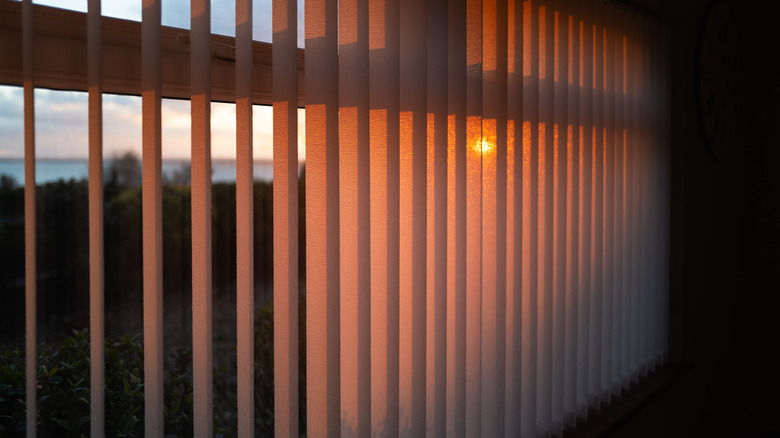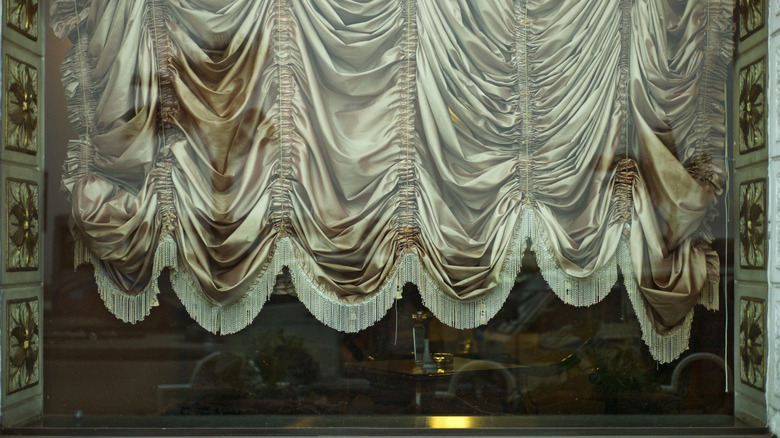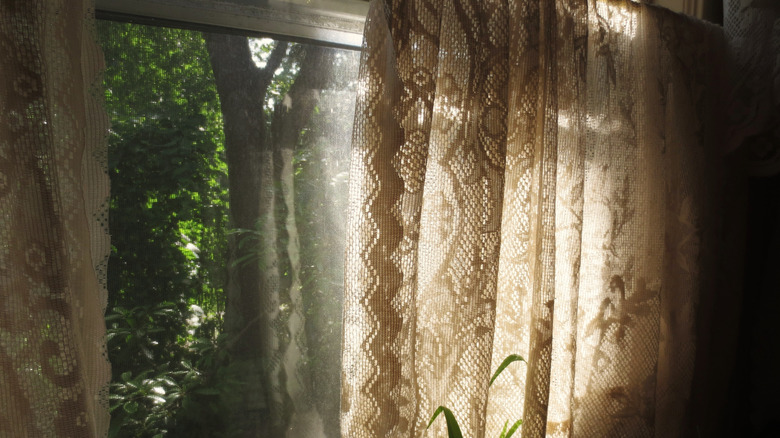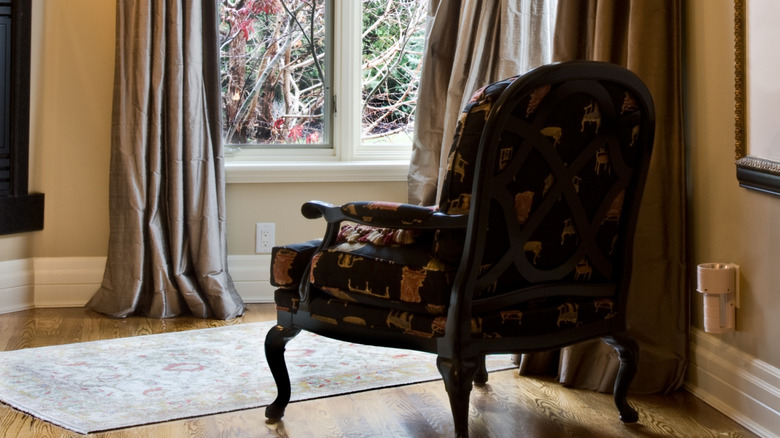Once-Popular Window Treatments That Are Now Dating Your Home
Window treatments can make or break the overall look of a room, so it's important to get them right. Like any decor, curtain trends come and go, so if you have any of these once-popular window treatments anywhere in your house, chances are they now look pretty dated. Of course, when learning how to decorate with popular curtain styles, it's easy to go astray. After all, trends tend to change so quickly that what was popular when you first decorated your house might have even looped back around to being once again en vogue.
However, the trends listed below don't seem to be coming back anytime soon since they are (currently) too heavy, impractical, and frustrating to deal with. In this House Digest exclusive, we spoke to several experts in the design industry to find out just what it is that everyone should be avoiding and what you need to be doing to your windows instead. Luckily, if your window treatments are dating your house and it's time to upgrade, it doesn't take more than an hour or two and requires almost no DIY prowess.
Heavy, overwhelming drapes make your room look stuffy
There is a time and place for rich velvet curtains — namely the lobby for the Tower of Terror at Disney World. If you have these in your home, it likely looks very dated, even if you live in an updated Victorian. "Those thick, velvet curtains with all the tassels and swags? Unless you live in a castle or you're starring in a period drama, it's time to let them go," Magda Callery, interior designer and owner of Style by Magda, exclusively tells House Digest. "They darken rooms and scream 'formal' when most of us look for cozy."
If you have an older home, you might have styled it with these drapes to try and fit the period, but oversized and super plush curtains aren't doing you or your space any favors. "In older homes, these used to be common to bring in a sense of luxury. Now, they make a room feel heavy and weigh it down," Bree Steele, interior designer and trade accounts manager at RJ Living, adds. To modernize the look without sacrificing style, Callery suggests lightening things up — literally. "Light and breezy linen or cotton drapes in neutral tones [fix the problem]," she says. "They soften the space without making it feel like a theater stage." A pair like Joydeco's Natural Linen Curtains can still give you privacy and that chic, elegant look. But, it won't make it look like you're living in a historic house museum that's frozen in time.
Valances were over years ago
For the uninitiated, a window valance is a decorative piece of fabric that covers the upper portion of a window. It's typically used to hide the curtain rods and make the window look a little bit nicer. Depending on how the fabric hangs, it might also be called a swag or a jabot. No matter the name or shape, our designers are over them. "I couldn't be more ready to leave traditional drapery valances behind! They are bulky and unattractive and instantly date a room," Jennifer Jones, principal designer at Niche Interiors, tells House Digest in an exclusive interview.
"Swags and jabots definitely date a house and project. Clean and simple panels look amazing and can often elevate your home," Eddie Rider, interior designer at Designers Lane Podcast, adds. "Put some attention to detail and add a beautiful drapery rod to finish the look. Operable or inoperable, be sure and choose what best fits your needs."
Both experts agree that exposed metalwork is better than bulky fabric bunched around the rods. Instead of covering the curtain rods, make them part of the room's decor and consider matching their material to other finishes in the space, like the light fixtures. For example, the Briofox Decorative Curtain Rod is sleek, adjustable, and comes in multiple finishes like brushed gold and matte black to blend seamlessly with your space.
Mini-blinds and shutters are too much hassle
Plastic blinds, mini-blinds, whatever you would like to call them — you've likely been annoyed by them at one point or another. Luckily, if you still have them in your home, you have our experts' full permission to get rid of them ASAP. "Remember those shiny, flimsy blinds that bent if you looked at them wrong? They're still around in some homes, but they've overstayed their welcome," Callery says. To swap these out, you don't even need much of a talent for DIY, either. Just head to your local hardware store and grab their replacement. "Wood or faux wood blinds significantly upgrade [a space]," Callery advises. "If you want more texture, woven shades add character without feeling fussy." All of these can be installed in just a few hours if that.
Plus, Callery isn't the only expert who thinks this way. "Mini-blinds and shutters have been out of style for a while, but if you still have these in your home consider swapping them out with flat fold or relaxed Roman shade," Jones adds. She recommends a fabric option because of the overall vibe and function it can bring to a room. "Not only do fabric window treatments add more softness to your space, Roman shades also let in more light than shutters and are easier to operate," she says. Luckily, there are still smart ways to repurpose these blinds when you no longer have use for them with some fun DIY projects. Then, replace them with a more modern window treatment like Chicology's Roman Shade which comes in lots of colors, sizes, and light-filtering options to meet your unique needs.
Vertical blinds also belong in the past
Large glass windows and doors do well to let in plenty of light, but you often need a touch of darkness — or privacy. This is why vertical blinds first became popular, but our experts agree that they have long run their course. Steele explains that these were popular spanning several decades from the 1950s into the new millennium. However, she explains, "While they are practical, they now have a commercial feel that doesn't really feel residential anymore." And she's right, as the only place that these blinds don't feel out of place is in sterile corporate offices right alongside the carpeted cubicles and abundance of fake plants.
Steele isn't the only one to feel this way, either. "If they clatter every time you touch them, they're dated. Vertical blinds were practical for sliding doors, but they're now about as stylish as a flip phone," Callery says. "Sleek panel track blinds or sheer curtains are a much better option. They look polished, glide smoothly, and won't make you cringe when you open them." Vertical blinds also tend to have a pesky trait of just one or two of them falling, leaving awkward gaps in the coverage. It's not worth it. Just take them all down to save yourself the hassle. Then, replace them with a sleeker option like Graywind's Sliding Light-Filtering Track Panels.
Balloon shades look like a bad prom dress
Balloon shades are window coverings that get their name because, well, they look kind of like balloons. Their fabric puffs up into soft, rounded folds at the bottom. They typically were used in more formal settings from about the 1950s onward. However, they are now well past their prime. "These puffy, over-the-top window treatments had their moment, but now they look like your windows are wearing a bad prom dress," Callery shares.
If you don't want your windows to look like they are stuck in the past, Callery recommends Roman shades instead. "[They are] a simple and chic upgrade. They give you the same functionality with a much cleaner and modern design," she says. Roman shades are made from fabric that folds neatly into horizontal pleats when raised. They can be manual or automatic, but because of how the curtain folds in on itself, it offers a much sleeker sightline. Instead of a baggy, puffy window treatment, you can swap things out for something much less cluttered looking. If you'd still like a similar silhouette with a modern twist, options like Comodex's Cordless Roman Shades feature panels that fold softly over each other, creating subtle curves.
Lace curtains are just for grandma's house
Once thought to be the epitome of style and grace, it's better to leave lace curtains out of your modern design plans. "Unless your goal is to recreate your grandma's living room, lace curtains are better left in the past," Callery warns. "They make a space feel overly traditional and dated." To get the same effect, the designer recommends you reach for, "sheer curtains in soft, plain fabrics instead." This is because they are light enough to still let in plenty of sun, just as lace curtains might, but they don't look old-fashioned and stuffy.
The reasoning behind this quick update is simple. "Your windows should feel like part of your home's personality—not a relic from decades ago," Callery continues. "A few modern updates can transform a room from tired to timeless without much effort (or tassels). And let's be honest — fewer cords and frills mean fewer headaches." Luckily, it doesn't take much time or effort to replace lace curtains. If you are really attached to the fabric and are looking for new ways to decorate with table runners, lace fabric can easily be hemmed and repurposed as one. They look fine on the table for a fancy tea party, just not on your windows.
Puddling drapes are too long for modern spaces
Drape length has a bigger impact on the overall vibe of the room than you might think. In fact, if the drapes are too long, your home might start to look more like a medieval castle than a modern oasis. "Drapes that puddle on the floor is another common trend that has come and gone," Jones says. "Your drapery panels should hang 1/4"-1/2" off the floor or barely 'kiss the floor' as the pros say."
Doing things this way has other benefits, too. Drapes with excess fabric on the ground can become a major tripping hazard. But by lifting them ever so slightly, you make your home just that much safer and more accessible without technically renovating. Plus, drapes that don't drag on the floor tend to be much easier to keep clean. They'll typically collect less animal hair and dust when they hover just above the ground. Remember, buying panels that are too long is just one of many mistakes to avoid when buying curtains. Instead, measure carefully before purchasing and wait to install the curtain rod until after you can thread the panels onto it. That way, you can play with the best placement on the wall before you drill any holes for the mounting hardware.
